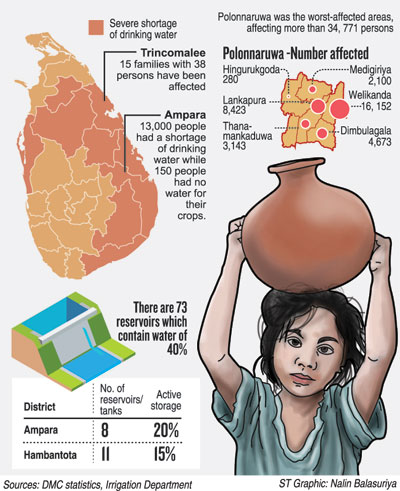News
Hundreds walk miles for water as drought bites
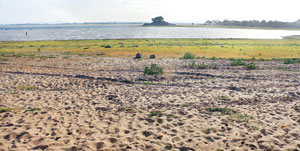
Polonnaruwa. Pic by Gamini Obeysekera
The severe drought prevailing in at least five provinces, including the North Central region, is forcing hundreds of people to walk several kilometers daily to fetch drinking water or look for bathing places.
In Polonnaruwa, one of the worst-affected areas, the drought has hit more than 34,000 people, the Disaster Management Center (DMC) said.
Communities in Monaragala, Ampara, Vavuniya, Batticaloa, Trincomalee, Puttalam, Anuradhapura, and Hambantota are also experiencing a severe shortage of drinking water.
Even small springs have been drying up, Polonnaruwa Disaster Management Assistant Director, Upul Nanayakkara said.
Villagers claim that bowsers are not visiting them frequently enough but Mr. Nanayakkara said the bowsers have sometimes to travel 30-40km from the water plants.
People needed water containers that could hold 50-100 litres but, being poor, they only possessed pots and buckets to store the water.
Polonnaruwa District Secretary Nimal Abeysiri said it was difficult to reach stricken communities every day because it was a long distance from Water Board plants to areas such as Dimbulagala, Welikanda, Lankapura, Hingurakgoda, Medirigiriya and Elahera.
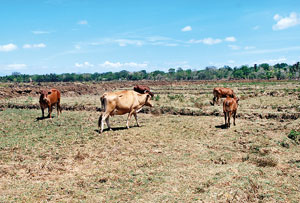
Kataragama. Pic by Janath de Silva
In the south, Hambantota district has 8,000 people suffering from the drought. Hambantota DMC Team Assistant Director K.K.M. Ravindra said although drinking water was being supplied daily and more bowsers were being hired, the agriculture sector was badly hit and the DMC and the Irrigation Department were putting in agro wells.
In Ampara, 13,000 people had a shortage of drinking water while 150 people had no water for their crops, District Secretary Mr. Neil De Alwis said. Water browsers were in operation but they were insufficient and long-term solutions such as reconstruction and de-silting of tanks and construction of new tanks were needed, Mr. de Alwis said.
Drought problems are beginning to affect Trincomalee, too; a senior officer of the Trincomalee District Secretary’s office relayed welcome news of donations of plastic water tanks, water barrels and bottled water from concerned individuals.
Senior officials emphasised the linkage between human activity and droughts. Rivers and reservoirs in many areas are not functioning properly due to siltation, sand-mining, unauthorised construction and cultivation, an official of the International Water Management Institute, Sri Lanka, said; trees and forests in catchment and reservation areas have given way to hotels and mansions.
“Preparation for drought … must go beyond mitigation and include steps to address this man-made scarcity,” the Director General of Department of Irrigation, Engineer S.S.L. Weerasinghe, said.
“This cannot be done without a coordinated effort at all levels of government.”
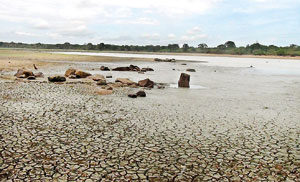
Hambantota. Pic by Rahul Samantha Hettiarachchi
The Irrigation Department oversees 73 reservoirs which are 40 per cent full. “We have restricted the release of that water as it is needed for the Maha season cultivation at the end of October and we will not release this water unless it is essential,” Eng. Weerasinghe said.
Minor tanks have almost completely dried up while the water levels of major tanks are receding fast, she said. The Irrigation Department was trying to build 10 new tanks in the dry zone.
“But more time is taken to get the land released than to build the tanks,” Eng. Weerasinghe said. “Finding land for tanks is very difficult due to development priorities.”
In Ampara, where there are eight major reservoirs, active storage has dwindled to 20 per cent and has been declared a critical level. It is the same in Hambantota that has 11 major tanks and the water levels are just 15 per cent,” she said.
| Mild weather a thing of the past“Sri Lanka has no mild weather now,” Meteorology Department forecaster Janaka Kumara said, referring to the effects of global warming. “Severe floods are experienced during rainy seasons and equally severe droughts follow.” The country was now experiencing 10-20 per cent less rainfall and temperatures – particularly along the west – have increased by 1.2C. “This is quite significant because it will affect the progress of the monsoon towards the north-central and eastern regions”, Mr. Kumara said. He said inter-monsoonal rains are expected in mid-October. |
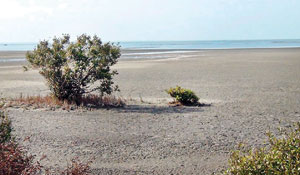
Puttalam. Pic by Hiran Priyankara Jayasinghe
